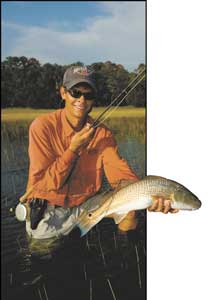
In my mid-20s, I taught myself how to fly fish for trout at mountain streams.One of the reasons it became — and still is — my favorite method of fishing is its intimacy with and connection to the fish and their environment. I just feel like a better fisherman when I’m wading through the current and can feel the subtle rhythms and pulses of the water, fish, and environment.
When fishing from a boat, I never feel the same intimacy with my quarry. There’s a psychological boundary that separates me from the watery world below. The water’s surface feels like a stark, forbidden line not to be crossed — physically or otherwise.
In the extreme, saltwater fishing always made me feel even more distant and the fish more inaccessible. The murky, mysterious ocean water might as well be a different universe altogether. The occasional uniting via the terminal ends of a thin strand of monofilament would be the only time I felt any connection with the fish below.
So when Captain Tuck Scott with Bay Street Outfitters at Beaufort called and offered to take me to a redfish flat where we’d wade through knee-high water for tailing fish, I didn’t hesitate to say yes.
This particular flat has a hard-bottom that’s garnished with glistening spartina marsh grass. It gets water during unusually strong high tides near full and new moons, and the redfish ride the surging water onto the flat.
We beached the boat at a small strip of land and slowly waded into the flat’s shallow water. It was a couple hours before high tide, and the flat was filling up quickly with water. With feet firmly on the bottom, we looked for tailing fish as slight current moved from my right to left.
I felt completely at home.
The spartina marsh grass was the key to the fish moving onto the flats. Spartina grass is a tall, green, rigid grass that hosts marsh snails by the thousands. Snails are what redfish eat when they move onto these flats.
The captain’s preferred fly was a Dupree’s spoonfly, a flashy, lightweight, easy-to-cast spoon/fly hybrid. An eight-weight fly rod and floating line seemed the perfect balance between making a soft presentation and having the backbone to handle potentially big fish.
Stalking these fish by foot, crouching down low with deliberate, fluid motions reminded me of some of the greatest, most efficient anglers in the world — herons and egrets.
Watching the feeding habits and total concentration these birds can be an excellent fishing lesson. “Be the heron” became my mantra for the afternoon.
The first tailing fish faced directly toward me at a distance of about 30 feet.
I crouched low and stripped some line from the reel, then flubbed the cast and spooked the fish. It left a lightning-fast wake through the shallow water.
I sheepishly looked around for Tuck to be sure he didn’t witness my disaster, but instead he had one on the end of his line and efficiently was bringing it toward him.
The atmosphere was dead still with no hint of a breeze in the air. These conditions would make the fish spookier than normal and longer casts would be required to be successful. Anglers ideally want a slight breeze to create some texture on the water’s surface to help hide their forms. A flat is just that — completely flat, and anything more than 4-feet high sticks out like a sore thumb.
No problem. “Be the heron; be the heron.”
The next tailing fish I saw within casting distance was slowly moving away. Again, keeping a low profile, I stalked into position and pulled out enough line from the reel. This time my cast unfolded and reached out to 40 feet before dropping the fly within 2 feet of the fish. One short strip of the line, and it stopped, the line tightened, and I felt the solid thump of a fish.
The rod doubled, and the strength of the fish reverberated through the line and rod to my hands. Then the leader broke. A loop of loose fly line had wrapped around the handle of the reel and my fish was gone. I uttered an oath under my breath.
During October and November, redfish become active feeders at the flats. Sp late fall, obviously, is one of the best times of the year to try this type of fishing.
“Baitfish move into deeper water at this time of the year so the fish become more aggressive feeders up on the flats,” Tuck said.
When we hit peak high tide at 6:23 p.m., it was time for us to go. Tuck didn’t say why.
“Hey, we still have a couple of hours of water in this flat,” I said.
I was dying to make up for my previous mistakes.
“Nope,” said Tuck. “As soon as the water starts to recede, the fish get out of here as fast as possible. The last thing they want is to get stranded in here.”
The boat ride back to the dock offered a glorious view of the sunset as scores of herons and egrets flew to their roosting areas for the night.
I was returning to my Beaufort hotel room to roost as well, with dreams of returning to these magical flats in search of tailing redfish.



Be the first to comment